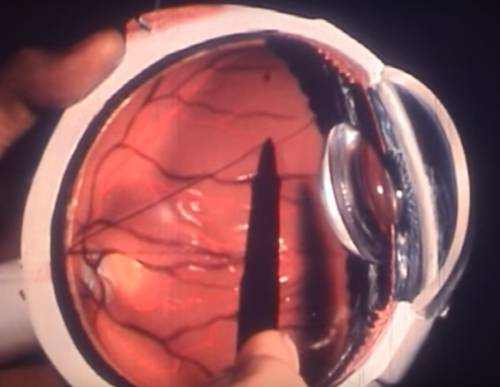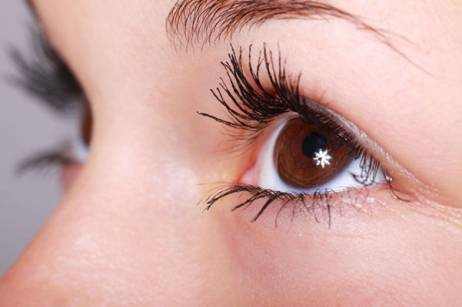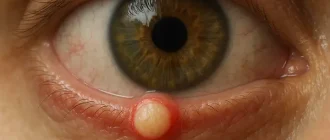Pterygium, commonly known as Surfer’s Eye, is a non-cancerous growth that develops on the conjunctiva, the clear tissue lining the eyelids and covering the eyeball. Usually occurring near the nose and growing towards the pupil, it can appear in one or both eyes and may cause vision issues in extreme cases.
The condition is primarily caused by excessive exposure to ultraviolet light, frequent exposure to wind, dust, and dry environments. Symptoms of pterygium include redness, irritation, and a sensation of having a foreign object in the eye.
Treatment options depend on the severity of the symptoms, ranging from over-the-counter eye drops to surgical removal in more advanced cases. To prevent pterygium, it’s essential to protect the eyes by wearing sunglasses and avoiding excessive exposure to harsh environmental factors.
Causes of Pterygium
Pterygium, commonly known as surfer’s eye, is a benign growth on the conjunctiva, the clear covering over the sclera or white part of the eye. The exact causes of pterygium are not fully understood, but it is believed to be a result of a combination of factors.
The primary cause is long-term exposure to ultraviolet (Pterygium, a common eye condition, is characterized by a fleshy, raised growth on the conjunctiva, the transparent tissue covering the white part of the eye. Although the exact cause of pterygium is still unknown, it is widely believed to be associated with prolonged exposure to ultraviolet (UV) radiation from the sun, as well as to environmental factors such as wind, dust, and dryness. People who spend a significant amount of time outdoors or in sunny climates are at a higher risk of developing pterygium.
It is important to protect your eyes from these factors by wearing sunglasses that block UV rays, using lubricating eye drops, and shielding your eyes from dust and wind to prevent or reduce the chances of developing this condition.

Symptoms of pterygium in one or both eyes
The symptoms of pterygium can affect one or both eyes and may range from mild to severe. Common signs of this condition include redness and swelling in the eye, primarily while the pterygium grows.
Additionally, individuals may experience a sensation of having a foreign body in their eye, along with irritation, dryness, or blurred vision. In some cases, the growth may be accompanied by a yellow spot or bump on the conjunctiva. It is essential to consult an eye care professional if any of these symptoms are persistent or worsening over time to ensure appropriate treatment and care.
Is pterygium dangerous?
In most cases, pterygium is not considered a dangerous condition. It is a raised, fleshy growth on the conjunctiva – the clear membrane covering the white part of the eye.
While the growth may cause some discomfort, redness, or mild irritation, it typically does not pose a serious threat to your vision. However, if left untreated and allowed to grow large enough to cover the cornea, it can lead to blurred vision and, in rare instances, scarring of the cornea.
In such cases, it is essential to seek medical treatment, which may include symptom-relieving eye drops or even surgery to remove the growth and prevent vision loss.
Difference between pterygium and pinguecula?
Pterygium and pinguecula are both eye conditions caused by exposure to ultraviolet (UV) light, wind, and dust. However, there are notable differences between the two. A pinguecula is a yellowish, non-cancerous growth on the conjunctiva, the transparent outer layer of the eye. It usually occurs near the nose and is caused by a deposit of protein, fat, or calcium.
On the other hand, a pterygium is a fleshy, vascular growth that starts as a pinguecula and can extend onto the cornea, potentially affecting vision. While pinguecula typically does not harm vision, pterygium may cause visual disturbances and, in severe cases, requires surgical removal to restore vision and prevent further growth.
How is pterygium diagnosed?
It is diagnosed through a comprehensive eye examination, typically involving a slit lamp examination. A slit lamp is a special microscope that focuses a narrow, bright line of light on the eye, enabling the eye care provider to closely examine the front and inner structures of the eye.
Based on the appearance of the tissue growth from the white part of the eye onto the cornea, the provider can confirm the presence of pterygium.
Early detection and preventive measures, such as wearing sunglasses with UVA and UVB protection, can help manage this condition effectively.
Treatment options
When dealing with pterygium in the eye, there are several treatment options available, depending on the severity and symptoms.
For mild cases, artificial tears or lubricating eye drops can provide relief from irritation and redness. In cases where the pterygium grows to a point that it affects vision, more serious intervention may be necessary.
Your eye doctor may recommend prescription eye drops, ointments, or even surgical removal if the growth alters the cornea’s curvature or looks more like a serious lesion. Pterygium surgery involves removing the growth under local anesthesia, with recovery generally taking about a month.
Post-operative care includes using antibiotic and steroid drops to prevent infection and reduce inflammation. It’s essential to consult with an eye care professional for appropriate treatment based on the particular severity and symptoms of each case.
Pterygium eye surgery
In mild cases of pterygium, eye drops and ointments may provide symptom relief. However, when the growth affects vision or causes significant discomfort, surgery is recommended. Modern surgical techniques, such as the no-stitch pterygium/autograft surgery, have significantly improved success rates and recovery times. This innovative procedure involves removing the abnormal tissue and replacing it with a graft of normal tissue, using a tissue adhesive to secure the graft in place without the need for stitches.
What to expect after surgery
After pterygium removal surgery, patients can expect a relatively quick and comfortable recovery process. Within just two days, most individuals are able to return to work and normal activities. In the first week following the procedure, the surgical adhesive used to secure the graft will dissolve, allowing the eye to continue healing.
Over the next two to four weeks, the eye will gradually return to its normal appearance, with minimal redness or irritation. It’s important to follow your doctor’s aftercare instructions, including taking prescribed medications and attending follow-up appointments, to ensure optimal healing and prevent potential complications.
Overall, patients can look forward to regaining their clear, healthy vision after pterygium surgery.





